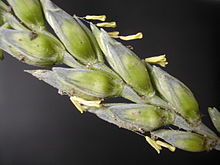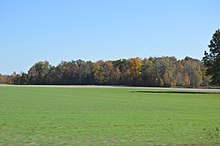Winter wheat
[1] Winter wheat is usually planted from September to November (in the Northern Hemisphere) and harvested in the summer or early autumn of the next year.So-called "facultative" wheat varieties need shorter periods of vernalization time (15–30 days) and temperatures of 3 to 15 °C (37 to 59 °F).In countries that experience mild winters, such as in South Asia (India, Pakistan, Nepal, Bangladesh), North Africa, the Middle East and the lower latitudes (e.g. Sonora in Mexico), spring wheat (not requiring a period of vernalization) is also sown in the autumn (November–December) and harvested in late spring (April–May) the next year.[6] Bernhard Warkentin and Mark A. Carleton played a major part in the spread of winter wheat as a commercial crop.Winter wheat production quickly spread throughout the Great Plains, and was, as it still is, usually grown using the techniques of dryland farming.


Winter wheat
Spring wheat
Winter Wheat (album)Triticum aestivumautumnvernalizationNorthern HemisphereSonoraRabi cropglutenbreadsEuropeNorth AmericaSiberiacash cropcover cropnitrogenseedbedOntariotopsoilfallowKansasRussian MennonitesMark A. CarletonUkraineUnited States Department of AgricultureRussiaKansas State UniversityGreat Plainsdryland farmingtemperate climateclimate changeBibcodeCommonMarquisNorin 10Red FifeEinkornKhorasanWheat diseasesWheat mildewHessian flyAustralian Wheat BoardCanadian Wheat BoardCorn exchangeExportsInternational Wheat CouncilPeak wheatProduction statisticsProtein premiumWheat pools in CanadaEndospermSproutsBerriesgroatsMillingFarinaMiddlingsSemolinaParboilingBulgurCouscousCrackerFlatbreadWheat beerWheat germ oilWheat glutenAnaphylaxisGluten-related disorderscoeliac diseasenon-celiac gluten sensitivitywheat allergydermatitis herpetiformisataxiaBread riotPlant breedingRefined grainsStaple foodWheatpasteWhole grainShatteringTell Abu HureyraTell Aswad